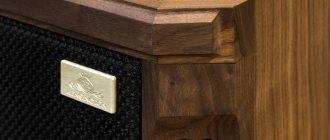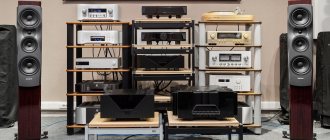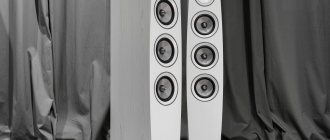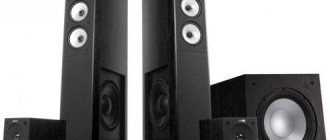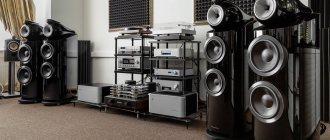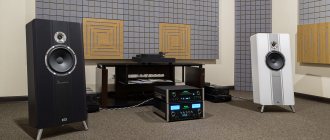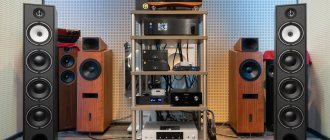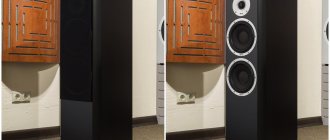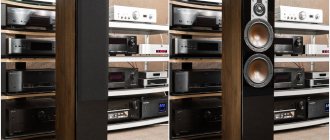It must be said that Canton has a special attitude towards the development and release of new lines. Developers sometimes come up with something completely new (just remember the line of soundbars), traditionally update popular lines every year, but there are models in the catalog whose history is measured in almost decades. This, for example, is the reference series.
The flagship Canton Reference line itself has been in production for a long time, but a few years ago the company decided to update it and released the Reference K (this letter “K” alone hides quite serious changes).
I positively assessed Canton’s attitude and approaches to development back in 2012, when I had the opportunity to visit the production facility in Germany, where this line is produced, and talk with the developers. The first and most important thing I noticed then was an extremely thorough approach, attention to detail and the research process, starting with computer modeling.
I remember Canton chief engineer Frank Gabel talking for about an hour about why such complex speaker surround profiles are developed, and almost as much about how everything is tested under different conditions and how much research goes into the anechoic chamber. And all this is only in relation to suspension profiles and some other structural elements, and besides them, in acoustics you can count dozens of mutually influencing each other parts and materials. Each element is modeled, the layouts are repeatedly modified - so that normal technical approaches, physics and mathematics are behind the final product.
I will assume that the new Canton Reference K line was calculated, modeled and prepared for release into series with all due attention and pedantry - the process ultimately took more than one year. In reality, I have no idea how much effort and time the engineers spent on the process of creating the Reference K, but I am sure that they did it very carefully and without haste.
Acoustics Canton Reference 1 K in a test system
The Canton Reference K line is very extensive - in addition to the flagship “unit” being tested, it includes three more models of floor-standing three-way speakers, differing in size and set of speakers, two-way bookshelf speakers, a center channel and an active subwoofer. That is, individual Canton Reference K models can be considered not only independently, but also as a potential set of acoustics for building a multi-channel system - the model range allows you to assemble a sufficient number of combinations.
Regarding design and performance: at first glance it becomes obvious that the acoustics under study are Canton Reference. However, it clearly inherits the features of the previous line; the shapes of the cases with their curves and many other design details are too recognizable.
Ceramics speakers
The Reference 1 K has a three-way design and a bass-reflex design of the low-frequency section. I note that the port is not located on the front or rear surface, but downwards, and is directed into the massive base of the speaker. But the most interesting thing about the design is, of course, the speakers. Here, aluminum diffusers, traditional for many Canton models, are replaced by metal-ceramic membranes.
Canton Reference 1K Midrange Speaker
And although the use of ceramics for such purposes occurs, this solution is still quite expensive and therefore rare. Here it is doubly interesting, since these are not ready-made speakers with ceramics in the designs purchased from someone, but their own developments.
No less significant is the fact that metal-ceramics in its various variations is used in all emitters of the Reference K line - these are dome tweeters, mid-frequency drivers, and low-frequency radiators. It is clear that a variety of materials of different compositions are used for the tweeter dome and the rest of the speakers, but all related to a combination of metals and ceramics.
The purpose of using such diffusers is clear - to achieve the greatest mechanical stability and precise operation of the speakers with minimal intrinsic coloration. For the same purposes, complex suspension profiles are used (I mentioned them earlier) and all other design elements, the total result of which comes down to creating the very performance characteristics and the sound that the developers intended.
The tweeter with a metal-ceramic dome is covered with a non-removable protective mesh
Canton Reference 1 K is a truly large speaker designed to work in large rooms. The manufacturer does not give exact recommendations, but even if you just estimate speculatively, the 134 kilograms of weight of each speaker and a total of four 12-inch woofers are difficult to fit into small rooms. It is also worth mentioning that these same dimensions and inches of woofers are very significant for many audiophiles - there have been so many disputes, how many beliefs exist that without a 12-15-inch bass driver there can be no full-size acoustics. And in many ways these statements are justified.
The acoustic bodies, despite their impressive size, look very elegant, primarily due to well-calibrated proportions and smoothed lines. This acoustics is far from the concept of a “box”. Massive bases also complement the design well. The cases of all Canton Reference K models are made of multi-layer laminate 5 centimeters thick. The manufacturer does not disclose the detailed composition of the sandwich, but the shells are clearly rigid and well damped.
Canton Reference 1 K speaker guards are made of two parts
The finish is strict, with options including black or white piano lacquer of excellent quality. The design also has neat, removable grills with magnetic mounts. What’s good is that the grills consist of two parts, one covers the low frequencies, and the second covers the mid frequencies and tweeter. A convenient solution that, if desired, allows you to cover only the low-frequency speakers, for which the presence of acoustic fabric is much less critical. By the way, separate grills are used not only in the “unit”, but also in younger floor-standing models.
The massive base of the acoustics into which the bass reflex port is directed. Also in the photo you can see some kind of waveguide
The support legs are metal, their design is simple. The only thing that can cause inconvenience is the sticker inserts on the legs, designed to avoid damaging the floor surface. It is not recommended to drag the acoustics, although with such a weight, any implementation of supports (except for wheels) is unlikely to make life easier for the owner - 134 kilograms does not imply options for easy movement.
In terms of functionality, the acoustics allow you to use a conventional connection, bi-wiring or bi-amping. I am very skeptical about bi-wiring, but using separate amplification can come in handy here - it takes a lot of power to drive such acoustics.
Switching terminals and jumpers designed for adjusting operating parameters
In this case, I was not able to see crossovers, but I saw those that were used in the previous line - a very high-quality and solid design with a good element base. On the rear panel of the speakers there are special jumpers that allow you to separately adjust the operation of the crossover in the low-frequency/mid-frequency section (from 100 to 300 Hz) and the tweeter (from 7 to 28 kHz) in the range of -1.5/0/+1.5 dB. A useful function is that the adjustment helps take into account some of the acoustics of the room and correct the nuances of sound, for example vocals.
By the time of the test, the acoustics had already worked sufficiently and were warmed up. In terms of placement, I had to trust the layout prepared for the test - it was not possible to move the columns during the process. However, the installation was carried out by good specialists, so I had no desire to change anything.
Test system: Mark Levinson No.585 integrated amplifier and McIntosh MCD550 CD/SACD player
Based on the test system, I have heard different Cantons paired with Mark Levinson before. Both manufacturers have complete order with continuity, so I expected predictable compatibility. According to my observations, this acoustics requires excellent quality, powerful amplification, and Mark Levinson fits this definition quite well, but then options are possible.
Sound: open and strict
To start, I put on Coleman Hawkins' "Good Old Broadway" CD. This is a very good digital reissue of an old recording, on which you can hear all the features introduced by the technology of those years. It happens that modern equipment plays such recordings dimly and flatly, giving preference to severely overcompressed editions of recent years. Usually the source is blamed for this, but acoustics can also make a significant contribution to the picture, as I have seen more than once. But here I heard a clear, detailed open sound with excellent nuances and completely unpressed dynamics.
There was no harshness in the sound as such (and the previous Canton Reference series had a noticeable amount of harshness), rather the sound was harmonious, moderately strict, without noticeable coldness or, on the contrary, warmth, perhaps a little dry. Or it’s just that old records themselves are more associated with a certain specificity inherent in them. The detail is high throughout the entire range, which, in turn, was worked out fully, without dips or distortions, the low-frequency section is not late. All instrumental parts with all sounds and overtones were clearly audible. The scale of the sound picture of the acoustics is truly impressive. The bass, as far as it can be assessed from this recording, is deep, fast and spacious. The mids are light, transparent, slightly cool, the same can be said about the upper frequencies.
The next album is Nicki Parrott & Ken Peplowski “Like A Lover”. The specifics of Venus Records releases are assessed differently, but this particular recording contains a very thick, viscous, but at the same time detailed and multifaceted bass. And the acoustics presented it as it is - powerful, large-scale, but not rude or heavy. The lower mids and upper bass were processed accurately, without clogging or masking the mid-frequency range.
I would like to note the multifaceted and correctly constructed stage, as well as the vocals, which sounded very detailed. Except that everything was played a little more strictly and dryly, and this is unusual. Although if you listen to all the components of the recording, you come to the conclusion that the picture as a whole is accurate and plausible. And another plus is speed: transitions, attenuation of notes, the ratio of quiet and loud sounds - the acoustics play all this not just well, perfectly! There is no feeling of the sounds fading away too quickly, but there is also no prolongation or feeling that the sounds are rushed or delayed.
Soundbar in a new way
Canton DM 90.3 and DM 55 are two audio systems that look like small soundbars, and even standing next to them, you don’t immediately understand what the secret is. The whole point is that this is not a thin “log” lying in front of the TV, but a large flat stand on which the TV stands. This approach has at least one undoubted advantage: the internal volume of the case is the same as that of two bookshelf speakers, which greatly increases the chances of getting high-quality, full-bodied sound.
In terms of accommodation, there are pros and cons. There is no way to attach such a design to the wall, which no longer allows us to call this form factor a potential “soundbar killer.” But if you put the TV on the stand, the situation changes. We place a regular soundbar in front of the TV, and in half of the cases it completely or partially blocks its IR sensor. Plus, modern designer TV supports are sometimes so intricate and wide that they make it difficult to place a soundbar close to the screen. You have to look for clever cabinets with a special niche or invent other installation options, combining a cabinet and a TV wall mount. Plus the subwoofer is another integral part of the system.
The Canton DM 90.3 is not just good, it has proof of this: an EISA 2015/2016 award in the Soundbar category
Having a Canton DM 90.3 or DM 55 at our disposal, we place the audio device on the cabinet, and then place the TV on top. The design of the audio system housing not only allows this, it is designed for it and will easily withstand any modern panel. Visually, the picture will be even prettier than with a regular soundbar, because the TV supports do not interfere. In addition, the IR sensor will be exposed. And if there is a special niche in the cabinet, it will be effectively used to its full depth, and there is no need to add a subwoofer. This approach fits well with the expectations of ordinary buyers of household audio equipment - it should be as compact, simple, and at the same time of sufficient quality. All the prerequisites for this exist.
Sound: detailed and seamless
I listen next to Sylvain Luc’s “Trio Sud” disc. This also has its own specifics - the sound of the acoustic guitar is slightly exaggerated on the recording, the bass is too soft, slightly swollen and blurred, and a large number of transitions from quiet, almost solo fragments to the simultaneous mixing of all instruments.
When listening, I was pleased with the intelligibility: instead of a sound mess, the result was musical unity. With good detail and simply excellent dynamics, the acoustics do not imply a rigid dissection of the music into individual sounds - the picture in any case remains integral. The acoustics convey emotions in a somewhat unusual way - everything seems to be audible, but a little strictly, restrained and conservative. And although there were no obvious overflows, I could not shake the feeling that it was about to overflow. Whether this is good or not - if possible, everyone will decide for themselves. Since all the effects are expressed very subtly, it is extremely difficult to give them an unambiguous assessment.
Yes, the speakers play strictly, even a little dryly, but at the same time very detailed. And this detail makes you want to consider each sound separately. But at the same time, music, as something whole and complete, envelops you. And this dialectic does not interfere with listening in any way; on the contrary, it captivates you - you want to listen and listen.
The next album is Richard Hawley's "Truelove's Gutter". Here I liked the accurate, detailed and three-dimensional reproduction of almost every note, as well as the fact that the music remained music. A slight coldness did not harm this album at all, and the absence of any other coloring - even more so. The information content of listening is high, but emotions, although they fade into the background a little, are still easy to read. In terms of presentation of the frequency range, everything here is equally good - bass, mids, and high frequencies - everything is solid and smooth. True, the stage was scaled larger than the recording required - the acoustics were still impressive, so listening to the tracks was a little unusual.
Sound: man and sea
If we take heavier music, for example, the My Dying Bride album “The Dreadful Hours”, we can conclude that the acoustic detail and truth are very high. While listening, you can clearly hear nuances that are often completely lost on other systems. However, the emotional component was unexpected for me: the acoustics clearly like the minor mood better, but there is no feeling of immersion; rather, it turns out to be a calm contemplation, although the emotional picture being contemplated fully corresponds to the work. Yet the level of emotional interaction between the listener and the music is less. To some extent, this is due to the fact that part of the attention is drawn to high detail, or perhaps due to the restraint and slight detachment of the sound.
12-inch woofer - in the entire line only Canton Reference 1 K has such drivers
To better illustrate these sensations, I will try to give this analogy - communication between man and the sea. Someone needs to take a swim, feel their body in the water, not paying attention to anything. But some people simply need the proximity of water, to see its various states - in a storm and in a calm, in the rays of the setting sun and in the light of the moon. Formally, immersion and direct contact do not occur, but the range of sensations is incomparably wider and deeper. Also with this particular listening to the acoustics being tested - this is rather the second case.
Another recording to listen to as part of the test is Cecilia Bartoli, Andras Schiff “Italian Songs”. Again, everything is excellent in terms of dynamics and detail, the scene is constructed correctly, there is not a hint of confusion or confusion anywhere. And although everything is there, this recording lacked a certain airy-emotional involvement for me. With almost holographic accuracy, knowing well what was recorded on the disc, including the meaning of these very songs, the effect of some detachment and understatement remained. However, I understand how different things Italy and Germany contributed to musical culture (at a time when there was neither a single Italy nor a single Germany), and I feel a little bit of this difference in musical culture, its emotional and semantic fullness. But here’s what’s interesting: for acoustics to emphasize such subtle moments—I’ve seen this very rarely. Typically, the nature of the technique is less multifaceted and less multi-layered.
Measurement results included with the acoustics
And the last entry in the test is Mahler's First Symphony, performed by the Chicago Symphony Orchestra under the direction of Klaus Tennstedt. It may not be the best performance, but both the recording and its modern edition are excellent. The air, the quiet sounds, the different groups and instruments in the orchestra are all beautifully recorded here.
First, let's go over the formal features. Wonderful stage, outstanding sound scale, ample amount of air. The orchestra can be heard very well, accurately and reliably. The dynamics, even in complex fragments, do not cause any complaints, and the detail also always remains confidently high. You can just listen and enjoy. Moreover, we are talking about large acoustics with an impressive sound, which is always very critical for symphonic music. Although it is worth noting that it is always somewhat easier for large floor-standing players to play such recordings than for bookshelf players (and those who are fully capable of this can be counted on one hand). But I’m testing floor-standing speakers, and comparisons here can be left at the level of theorizing, but in fact it turns out that any acoustics that play symphonic music fully and without quibbles are a rarity.
Hidden Features
Despite their apparent simplicity, both devices are very functional and can be flexibly configured in accordance with current conditions of use. Both DM 55 and DM 90.3 have a built-in Bluetooth module version 3.0 with apt-X support, allowing you to listen to music from your smartphone in high quality. The system is in fact stereophonic, but using the remote control you can select modes - stereo or surround sound. Please note that the ability to listen to music is not nominal; an honest stereo pair can be obtained by pressing one button.
Canton also has special solutions in store for cinema. In addition to surround sound, the devices are capable of performing Lip sync correction if the time of sound output does not coincide with the picture. Since the manufacturer cannot predict exactly where the soundbar will be placed (closer to the floor or high, closer to the listener’s ear level), the menu has three equalizer modes corresponding to different installation options.
A small remote control is included in the package, but the soundbar can be trained to understand the signals of any other remote control
Separately, I would like to draw attention to the possibility of teaching soundbars commands from another remote control. With this feature, your own Canton remote can be replaced with a TV remote. Without a doubt, this is more convenient than juggling remote controls in search of what you need. The programming process is described in detail in the Russian-language instructions. Both devices have this feature, but the DM 90.3 has CEC support, so if your TV is compatible with this technology, everything becomes even easier.
conclusions
Very versatile acoustics. The sound is undoubtedly accurate and uncolored. The detail and dynamics are very high, while there is even elaboration of the entire range; dips or restrictions at the edges are not felt at all. The genre versatility is obvious. Add to this the outstanding scale and volume - the acoustics themselves are large, and this is not only obvious, but also audible. It is absolutely impossible not to take into account the size of the room when choosing such a model. And it’s worth thinking about the properties of the room itself.
There is some specificity in the presentation - a slight emotional detachment, severity, although not turning into obvious harshness and not accompanied by excessive harshness. In different systems and with different components, the character of the sound will definitely change, so I would recommend avoiding, on the one hand, using components (amplification) with a sharp, harsh or emphatically bright sound. However, devices with a clearly warmed, softened or washed-out sound also do not look suitable, especially if you want to get the detail and dynamics that these acoustics are capable of.
Let's watch a movie
The first film fragment was from the film “Everest”: a snow storm trying to destroy the climbers’ tent camp, heart-rending screams drowned out by snow charges, breaking cables. Next, we watch the episode of the explosion on the ship in the “Battle of the Blackwater” from the endless television saga “Game of Thrones”. A powerful wave of swirling green fire, devouring everything in its path, is moving straight towards me. The center channel and surround speakers demonstrate amazing teamwork. You can hear literally everything - every sound and rustle, every remark.
Canton 80.2 active subwoofer - a powerful, low-frequency basis for any home entertainment
I catch myself thinking that the sound of the system in the cinema, although not without charm, is as if projected onto the walls of the room, and stubbornly does not want to break away from them towards the listener in order to become truly three-dimensional. When watching the film, there was a feeling that the sound field was insufficiently dense, which, given the potential of the equipment, at least should not have disappointed us. In conversations with installers, I often hear that it is at least unreasonable to trust systems for automated configuration of multi-channel systems, so in our case it is better to simply disable it, performing this simple procedure manually once. I am confident that the result will exceed our wildest expectations.
